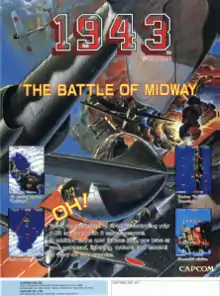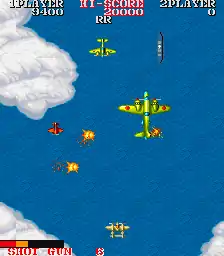1943: The Battle of Midway
1943: The Battle of Midway (1943 ミッドウェイ海戦, Ichi Kyū Yon San: Middouei Kaisen) is a 1987 shoot 'em up arcade game developed and published by Capcom.[1] It was the first follow-up to Capcom's earlier 1942. The game's name is a reference to the Battle of Midway, which in actuality happened in June 1942.
| 1943: The Battle of Midway | |
|---|---|
 North American arcade flyer | |
| Developer(s) | Capcom |
| Publisher(s) | Capcom |
| Designer(s) | Yoshiki Okamoto |
| Composer(s) | Original release: Kumi Yamaga 1943 Kai: Manami Matsumae Takashi Tateishi Junko Tamiya Hiroshige Tonomura Tamayo Kawamoto Harumi Fujita |
| Platform(s) | Arcade, NES, PC Engine, Xbox, PlayStation 2, PlayStation, Sega Saturn, PlayStation Portable, Xbox 360, Xbox One, Atari ST, ZX Spectrum, Amstrad CPC, Commodore 64, Commodore Amiga, PlayStation 3 |
| Release | June 1987 (Arcade) |
| Genre(s) | Vertical scrolling shooter |
| Mode(s) | Single-player, 2 player Co-op |
| Arcade system | Capcom Commando Hardware |
Gameplay

The game is set in the Pacific theater of World War II, off the coast of the Midway Atoll. The goal is to attack the Japanese air fleet that bombed the American aircraft carrier, pursue all Japanese air and sea forces, fly through the 16 stages of play, and make their way to the Japanese battleship Yamato and destroy her. 11 of these stages consist of an air-to-sea battle (with a huge battleship or an aircraft carrier as the stage boss), while 5 stages consist of an all-aerial battle against a squadron of Japanese bombers with a mother bomber at the end.
As in 1942, players pilot a P-38 Lightning. Controls are also similar: button 1 fires main weapons, and button 2 performs two special actions: a loop maneuver like in 1942, or one of three special lightning attacks in exchange for some of the player's fuel. Indeed, players now have only one life, in the form of a large "fuel" meter; constantly depleting, but refillable by collecting various powerups (chiefly "Pow" icons). In 2-player mode, when both players overlap their planes on screen, the energy bar can be transferred from the player with more fuel to the player with less. Destroying a complete formation of red enemy planes will result in a power-up, such as a health boost or a new main weapon.
There are cheat codes, different for every stage, ranging from holding down a fire button or pointing the joystick in a certain direction; player(s) are rewarded with fully upgraded weapons.
Ports
Capcom released their own port for the NES, but the game has also been ported to the Atari ST, the ZX Spectrum, the Amstrad CPC, the Commodore 64 and the Amiga. In 1998 it was rereleased as Capcom Generation 1 for the Sega Saturn and the PlayStation. In 2005 it was re–released for Xbox and PlayStation 2 as part of Capcom Classics Collection, and again in Capcom Classics Collection: Reloaded on the PlayStation Portable. It also included as the initial game in Capcom Arcade Cabinet, a compilation of games released digitally for PlayStation 3 and Xbox 360 on February 19, 2013 in which the games are sold individually or in packs. The overall faithfulness and quality of execution of these third party versions varies greatly.
NES
Released exactly one year after the arcade version, the NES version of 1943 introduced the ability to improve the player's plane by permanently upgrading certain aspects of its abilities. These include the plane's offensive and defensive powers, the maximum fuel level, and its special weapons and their durations. This somewhat alters the game balance and a different tactic is required to survive the game. For example, initially very few weapons are made available; more can be attained from power-ups by putting statistic points into "special weapons ability".[2]
Kai
Developed and released alongside the Family Computer version, 1943 Kai: Midway Kaisen (1943改 ミッドウェイ海戦) is an arcade game, an "alternate" version of the original 1943, released in 1987[3] in Japan.
In 1991, this version was converted to the PC Engine as simply 1943 Kai, again exclusively in Japan; this version contains many additional levels and original music.
Although the arcade release was exclusive to Japan, the arcade version itself was included in the 1998 Capcom Generations for the Sega Saturn and the PlayStation and in the 2005 Capcom Classics Collection for PlayStation 2 and Xbox.
Reception
In Japan, Game Machine listed 1943: Midway Kaisen on their July 15, 1987 issue as being the most-successful table arcade unit at the time.[4] Game Machine also listed 1943 Kai: Midway Kaisen on their August 1, 1988 issue as being the sixteenth most-successful table arcade unit at the time.[5]
History
The Battle of Midway was fought between the Imperial Japanese Navy commanded by Isoroku Yamamoto and the United States Navy commanded by Chester W. Nimitz. This battle took place just 7 months following the Attack on Pearl Harbor on June 4, 1942. Following the surprise attack on Pearl Harbor as well as their tactical victory at the Battle of the Coral Sea, Yamamoto firmly believed that an assault near the small island of Midway would lead to a decisive victory for Japan. This ended up being a decisive victory however not in Japan's favor.
Admiral Nimitz led the US Navy to victory with a strategy based on intelligence, counter-intelligence, and better decision-making. With the aid of Naval cryptographers, Nimitz was given the opportunity to deal with the logistics required to counter-attack the Japanese navy.[6] The forewarning Admiral Nimitz received about the impending attack turned what would have been a critical defeat into a decisive victory for the Navy.
References
- "1943: The Battle of Midway". The International Arcade Museum. Retrieved 3 Oct 2013.
- This version does not bear a subtitle, though packaging gives the original Japanese release "The Battle of Valhalla" and the US release the normal "The Battle of Midway". Further, a Japan-bound prototype exists named 1943: The Battle of Midway.
- 1943 Kai - Midway Kaisen on arcade-museum.com
- "Game Machine's Best Hit Games 25 - テーブル型TVゲーム機 (Table Videos)". Game Machine (in Japanese). No. 312. Amusement Press, Inc. 15 July 1987. p. 29.
- "Game Machine's Best Hit Games 25 - テーブル型TVゲーム機 (Table Videos)". Game Machine (in Japanese). No. 337. Amusement Press, Inc. 1 August 1988. p. 29.
- https://www.history.navy.mil/content/history/nhhc/research/library/online-reading-room/title-list-alphabetically/b/battle-of-midway-3-6-june-1942-combat-narrative.html
External links
- 1943: The Battle of Midway at the Killer List of Videogames
- 1943: The Battle of Midway at SpectrumComputing.co.uk